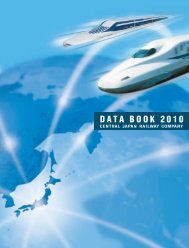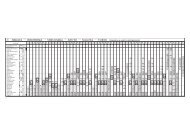CENTRAL JAPAN RAILWAY COMPANY Annual Report 2007
CENTRAL JAPAN RAILWAY COMPANY Annual Report 2007
CENTRAL JAPAN RAILWAY COMPANY Annual Report 2007
Create successful ePaper yourself
Turn your PDF publications into a flip-book with our unique Google optimized e-Paper software.
Conventional Railway<br />
Conventional Line Operation System<br />
JR Central’s 12 conventional lines are controlled from three control centers including<br />
the Tokai General Control Center. Each of the centers collects train status information,<br />
including information on train position, and station signals, as well as facility operation<br />
status information, such as power supply and signal communications, to monitor the<br />
operational status of trains and the utilization of facilities 24 hours a day.<br />
Centralized Traffic Control (CTC)<br />
The CTC system efficiently controls train operations through the centralized remote<br />
control of station signals. The system is also equipped with functions for real-time<br />
monitoring of the operational status of trains. By using the CTC system, JR Central is<br />
able to manage train and station information at its control centers. Such centralization<br />
allows orders and directives to be issued more rapidly than for a standard train control<br />
system, not only in ordinary situations but also in emergency situations. And JR Central<br />
has implemented the CTC system on almost all of its lines, thus ensuring reliable train<br />
management.<br />
ATS: Automatic Train Stop<br />
ATS is a system for automatically applying the train’s emergency brake in situations<br />
where the train risks overrunning. JR Central has introduced ATS-ST systems on all<br />
lines. They have functions such as immediately applying the emergency brake if the<br />
train passes over an ATS ground coil located in front of station and departure signals<br />
when such signal indicates that the train should stop. We have also expanded the<br />
functions of the conventional ATS and improved safety.<br />
To further promote safety on conventional lines, as current ATS-ST systems need<br />
replacement due to deterioration, we are replacing the systems with an ATS-PT system,<br />
which exerts continual monitors the train’s speed in accordance with the distance<br />
between the running train and signals and applies the emergency brakes if the train<br />
exceeds allowable speeds. We plan to introduce the ATS-PT system by fiscal 2010 on<br />
the Tokaido line (between Atami and Maibara), Chuo Line (between Nagoya and<br />
Nakatsugawa), Takayama Line (between Gifu and Mino-Ota), Kansai Line (between<br />
Nagoya and Kawarada) - and on all lines by fiscal 2011.<br />
Doctor Tokai<br />
As for the maintenance and management of railway tracks and electrical facilities, the<br />
use of the “Doctor Tokai” multiple inspection train, introduced in 1997, has enabled the<br />
efficient and early monitoring of facility conditions. Following on from Doctor Tokai’s<br />
long track record of steady and reliable inspections for approximately ten years, JR<br />
Central introduced an additional track inspection train, known as “Doctor II”, in April<br />
2006. The new train is equipped with the latest technologies, and will allow us to further<br />
improve our ability to carry out a frequent high precision track testing.<br />
CTC Area<br />
Inotani<br />
Shiojiri<br />
Takayama Line<br />
Tatsuno<br />
Mino-Akasaka<br />
Chuo Line<br />
Mino-Ota<br />
Ogaki Gifu<br />
Kofu<br />
Maibara<br />
Taita Line<br />
Iida Line<br />
Tajimi<br />
Minobu Line<br />
Kyoto Kansai Line<br />
Nagoya<br />
Gotemba Line<br />
Kameyama<br />
Obu<br />
Fuji<br />
Shin-Osaka<br />
Taketoyo Line<br />
Kozu<br />
Toyohashi<br />
Numazu Atami<br />
Meisho Line<br />
Taketoyo<br />
Tokaido Line Shizuoka<br />
Matsusaka<br />
Ise-Okitsu Taki<br />
Sangu Line Tokaido Shinkansen<br />
Shingu<br />
Kisei Line<br />
Toba<br />
CTC system completion area<br />
Comparison between ATS-ST and ATS-PT<br />
ATS-ST<br />
Introduction of ATS-PT<br />
Inotani<br />
Shiojiri<br />
Takayama Line<br />
Tatsuno<br />
Mino-Akasaka<br />
Chuo Line<br />
Ogaki<br />
Mino-Ota<br />
Gifu<br />
Nakatsugawa Kofu<br />
Maibara<br />
Taita Line<br />
Iida Line<br />
Tajimi<br />
Minobu Line<br />
Kansai Line<br />
Kyoto<br />
Nagoya<br />
Kawaharada<br />
Gotemba Line<br />
Obu<br />
Kameyama<br />
Fuji<br />
Taketoyo Line<br />
Kozu<br />
Shin-Osaka<br />
Toyohashi<br />
Taketoyo<br />
Numazu Atami<br />
Meisho Line<br />
Shizuoka<br />
Matsusaka<br />
Ise-Okitsu Taki Sangu Line<br />
Tokaido Line<br />
Shingu<br />
Kisei Line<br />
Toba<br />
To be introduced by fiscal 2010<br />
To be introduced by fiscal 2011<br />
Tokyo<br />
Driver is warned and must react within five seconds<br />
Ground coil Ground coil<br />
(Alarming point) (Speed check)<br />
ATS-PT<br />
Braking Pattern<br />
Ground coil<br />
(Pattern generation)<br />
Station signal<br />
Ground coil below signal<br />
(Immediate stop)<br />
Speed is continuously checked.<br />
At any given speed, if the speed<br />
exceeds the pattern the emergency<br />
brake activates.<br />
Station signal<br />
Series 313<br />
13





